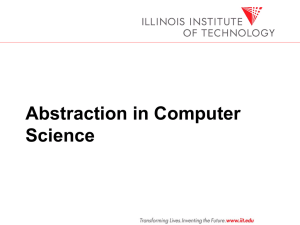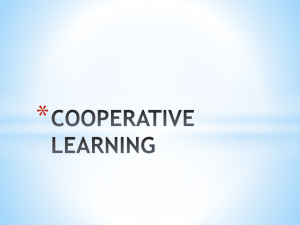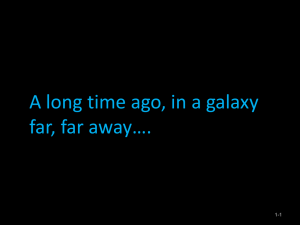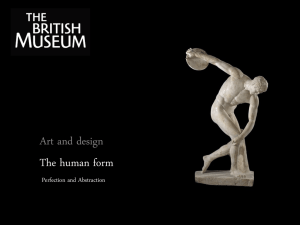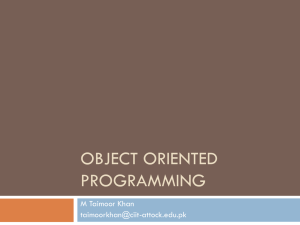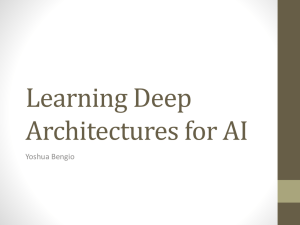Activity 1.4.1 Procedural Abstraction Introduction
advertisement
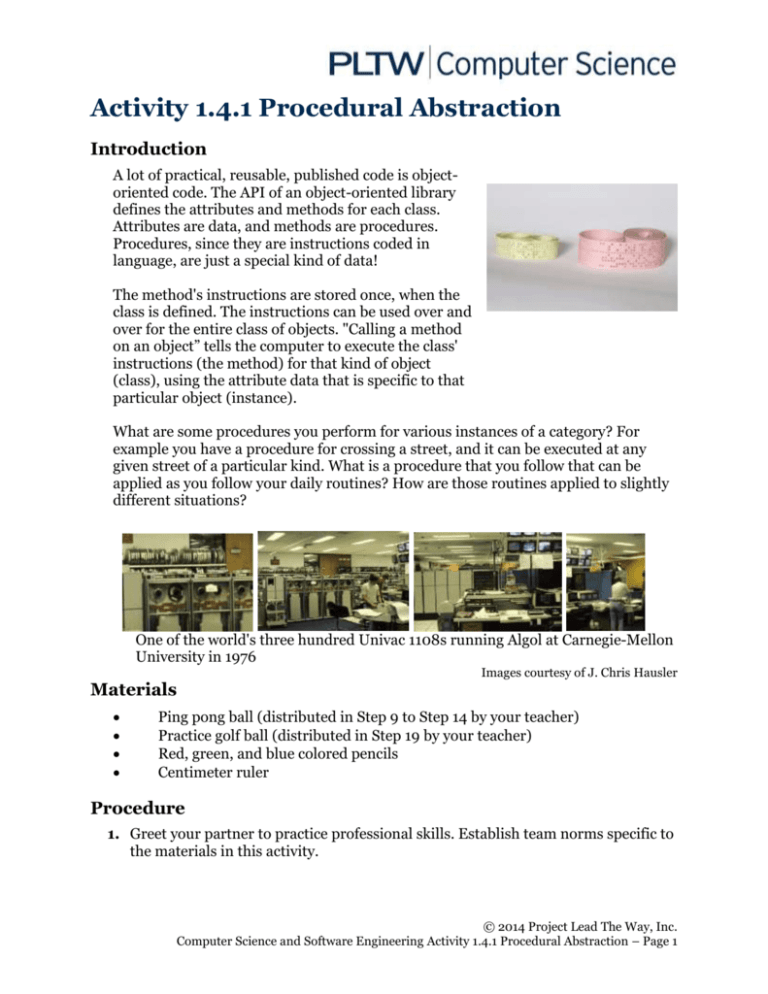
Activity 1.4.1 Procedural Abstraction
Introduction
A lot of practical, reusable, published code is objectoriented code. The API of an object-oriented library
defines the attributes and methods for each class.
Attributes are data, and methods are procedures.
Procedures, since they are instructions coded in
language, are just a special kind of data!
The method's instructions are stored once, when the
class is defined. The instructions can be used over and
over for the entire class of objects. "Calling a method
on an object” tells the computer to execute the class'
instructions (the method) for that kind of object
(class), using the attribute data that is specific to that
particular object (instance).
What are some procedures you perform for various instances of a category? For
example you have a procedure for crossing a street, and it can be executed at any
given street of a particular kind. What is a procedure that you follow that can be
applied as you follow your daily routines? How are those routines applied to slightly
different situations?
One of the world's three hundred Univac 1108s running Algol at Carnegie-Mellon
University in 1976
Images courtesy of J. Chris Hausler
Materials
Ping pong ball (distributed in Step 9 to Step 14 by your teacher)
Practice golf ball (distributed in Step 19 by your teacher)
Red, green, and blue colored pencils
Centimeter ruler
Procedure
1. Greet your partner to practice professional skills. Establish team norms specific to
the materials in this activity.
© 2014 Project Lead The Way, Inc.
Computer Science and Software Engineering Activity 1.4.1 Procedural Abstraction – Page 1
2. Computing relies on layers of abstraction. In two previous activities, you focused
on abstraction.
Data abstraction lets us ignore the details of how numbers, letters, sound,
and images are represented. We can generalize a data type.
Programs are data, too! Procedural abstraction lets us ignore the details of
how instructions are executed. We can generalize an instruction.
Recall one or more steps or ideas from past activities and share with your
partner.
Part I: The abstraction of objects, at a low layer of abstraction
3. In this activity we climb up and down the ladder of abstraction with objectoriented programming. Before working from the top of the ladder, let's take a
moment to dive down near the bottom of the ladder of abstraction to the layer
where data are stored. In the early days, that was on magnetic or hole-punched
tape.
Alan Kay, one of the giants of computer science, coined the term "object-oriented"
to describe ideas he learned from Trygve Reenskaug, a Norwegian graduate
student at the University of Utah. Writing years later, Kay recalls analyzing
Reenskaug's program, which allowed multiple people to work simultaneously on a
huge drawing.
I actually walked into Dave Evans’ office looking for a job and a desk.
On Dave’s desk was a foot-high stack of brown covered documents, one
of which he handed to me: “Take this and read it.”
Alan Kay, The Early History of Smalltalk
© 1993 ACM
It was 1966. Kay recalls how every new graduate student got one of those
files. He describes looking inside Reenskaug's documentation, which
explained where Trygve had left off:
The title was “Sketchpad: A man-machine graphical communication
system,” by Ivan Sutherland in 1963. What it could do was quite
remarkable, and completely foreign to any use of a computer I had ever
encountered.
...Head whirling, I found my desk. On it was a pile of tapes and listings,
and a note: “This is the Algol for the 1108. It doesn’t work. Please make
it work.”
...The documentation was incomprehensible. Supposedly, this was the
Case-Western Reserve 1107 Algol–but it had been doctored to make a
language called Simula. The documentation read like Norwegian
transliterated into English, which in fact it was. There were uses of
words like activity and process that didn’t seem to coincide with normal
English usage. Finally, another graduate student and I unrolled the
© 2014 Project Lead The Way, Inc.
Computer Science and Software Engineering Activity 1.4.1 Procedural Abstraction – Page 2
program listing 80 feet down the hall and crawled over it yelling
discoveries to each other.
--Alan Kay, © 1993 ACM
Alan Kay and his colleague learned from Trygve Reenskaug the idea of storing
data to be used by procedures alongside data for executing procedures. How
would these data have been represented on paper tape?
Part II: The abstraction of objects, at a high layer of abstraction
4. The brown-covered envelope Kay refers to contained high-level documentation.
High-level documentation for a program omits most of the details. Why is highlevel documentation important?
5. High level documentation for object-oriented code shows class diagrams and
indicates how the diagrams are related to each other. A class diagram shows three
things:
class name
list of attribute names
list of method names
Reenskaug's documentation included class diagrams very similar to today's
standard. This image of Reenskaug's work reproduced from The Early History of
Smalltalk is close to our modern standard!
In the 1990s the majority of programmers began to work in the object-oriented
programming paradigm. The diagrams became standardized in Unified
Modeling Language (UML). UML was adopted as the standard for
communicating and documenting software design in 1997 by the standards
consortium OMG (Object Management Group). OMG had been created eight
years earlier by eleven companies, including IBM, Apple, HP, Sun, American
Airlines, and Data General.
What problems are created if people don't collaborate to create standards?
© 2014 Project Lead The Way, Inc.
Computer Science and Software Engineering Activity 1.4.1 Procedural Abstraction – Page 3
6. The Python® programming language uses a dot notation to refer to the attributes
of an object and to call the class' methods on an object. For example we used the
AxesSubplot class and called set_title() on ax, which was an AxesSubplot:
ax.set_title('My picture')
Here is the AxesSubplot class described with a UML diagram:
AxesSubplot
title
...
class name
attribute names
method names
set_title()
...
What is another method from AxesSubplot that would be listed in this UML
class diagram?
7. Consider the following class:
class name
PingPongBall
radius
color
attribute names
draw_circle()
method names
Many programming languages support programming in the object-oriented
programming paradigm. In all of the languages that support object-oriented
programming, if you instantiate an object in the class described by this UML, the
computer stores the object's attribute data. You can then call the class' methods
on the object.
In the Python programming language, you might use the PingPongBall class
like this:
In[a]:
In[b]:
In[c]:
In[d]:
import realityArtist as fiat
mike = fiat.PingPongBall()
print mike.color
mike.draw_circle()
We will explore these four commands to understand what they do. The import
statement executes the class definitions in realityArtist and gives it the
nickname fiat.
In[a]:
import realityArtist as fiat
Where is the class definition? It is code in the realityArtist module, and it
might look like this. This is how a new class is created. You won't have to create
classes in this course, but we're glancing at the magic behind the curtain.
© 2014 Project Lead The Way, Inc.
Computer Science and Software Engineering Activity 1.4.1 Procedural Abstraction – Page 4
1
2
3
4
5
6
7
8
9
10
11
12
13
14
15
16
17
18
19
20
21
22
# module realityArtist.py
class PingPongBall(object):
def __init__(self, myRadius=20, myColor='#BB7700'):
""" Creates a new PingPongBall
radius expressed in millimeters
color is expressed in a 6-digit hexadecimal
color defaults to xBB red and x77 green (orangish)
"""
# Implement with a human so that:
self.radius = myRadius
self.color = myColor
def draw_circle(self, diameter=10, color='#FF0000', fill=False):
""" Draws a circle on a random location on the ball
uses colored pencil
diameter is expressed in millimeters
color is expressed in a 6-digit hexadecimal string
default color red
"""
# Implement with human
Once this code is executed with the import statement, the computer knows how
to create objects of the class. The constructor function in Python, which
instantiates the class, is always the special function __init__(). Instead of being
called with __init__(), it is called by using the class name. To reinforce
concepts with a tactile activity, we have made up (tongue-in-cheek) a blend of
"People" and Python. Lines 10 and 22 comment that a human will
implement part of the code!
Computers aren't used in this activity. It is an "unplugged" activity.
How many arguments does the __init__ function definition have?
The self argument is always first in class function definitions. It refers to the
object being instantiated or the object on which the method is called.
8. Now we'll instantiate a PingPongBall.
In[b]: mike = fiat.PingPongBall()
Why is fiat there?
Your teacher should manifest a ping pong ball using the specified arguments,
here defaulting to 20 mm radius and orangish color. Hand it to Mike. If there's
no Mike in your class, use someone else and pretend his/her name is Mike.
9. Record what you think the next line would print.
In[c]: print mike.color
© 2014 Project Lead The Way, Inc.
Computer Science and Software Engineering Activity 1.4.1 Procedural Abstraction – Page 5
10. Before we instantiate more PingPongBalls, let's see mike draw a circle.
In[d]: mike.draw_circle()
According to the docstring above, this code draws a random circle on the ball.
According to the default parameters, what size and color will be drawn? The
student Mike should draw that circle.
11. What lines of code would instantiate a ball called emily and then draw the black,
red, and gray circles as shown in the picture below? Record the code below. After
the classroom discusses it, "execute" the code so that Emily gets a ping pong ball
and draws on it.
In[e]:
In[f]:
In[g]:
In[h]:
... :
12. Now we'll make an aggregator to remember all the PingPongBalls in the
classroom.
In[i]: items = [mike, emily]
As a classroom of students, instantiate more PingPongBalls.
In[j]: for i in range(6):
... :
items.append(PingPongBall())
What is items[1] ?
What is items[3].color?
13. As a classroom, implement this code.
In[k]:
items[3].draw_circle(myColor='#00FF00', diameter=6)
Describe what it did.
© 2014 Project Lead The Way, Inc.
Computer Science and Software Engineering Activity 1.4.1 Procedural Abstraction – Page 6
14. As a classroom, implement this code.
for pingpong in items:
In[l]:
...
:
pingpong.draw_circle(diameter=6, fill=True)
Describe what it did.
15. As a classroom, implement this code.
In[m]: for pingpong in items:
... :
pingpong.append(PingPongBall())
Describe what it did.
16. Now we will define a new class, shown in UML and Python below.
class name
GolfBall
radius
color
attribute names
draw_circle()
method names
The Python below continues the realityArtist module shown above.
1
23
24
25
26
27
28
29
30
31
32
33
34
35
36
37
38
39
40
41
# module realityArtist.py
class GolfBall(object):
def __init__(self, myRadius=38, myColor='#FFFFFF'):
""" Creates a new practice-style GolfBall
myRadius expressed in millimeters
myColor is expressed in a 6-digit hexadecimal
"""
# Implement with a human so that:
self.radius = myRadius
self.color = myColor
def draw_circle(self, diameter=5, color='#00FF00', fill=True):
""" Draws a circle on a random location on the ball
uses colored pencil
diameter is expressed in millimeters
color is expressed in a 6-digit hexadecimal string
"""
# Implement with human
What are some differences between the GolfBall and PingPongBall classes?
17. As a classroom, implement this code.
In[n]: for i in range(8):
... :
items.append(GolfBall())
© 2014 Project Lead The Way, Inc.
Computer Science and Software Engineering Activity 1.4.1 Procedural Abstraction – Page 7
Describe what it did.
18.As a classroom, implement this code.
In[o]: for ball in items:
... :
ball.draw_circle()
Describe what it did.
Part III: The abstraction of objects, at another high layer of abstraction
19. As a classroom, design an abstraction for a class of objects. Your teacher will guide
you in this step. Record the abstraction in UML here.
class name
attribute names
method names
20. Abstraction is defined by the following two characteristics.
Discarding some details
Generalizing
Describe some of the details that were lost and describe what generality was
gained with the abstraction from the previous step.
21. As a team of two, design an abstraction for a class of objects. Record the
abstraction in UML here.
class name
attribute names
method names
22. Software developers often use UML diagrams to describe their ideas during the
early stages of software development. Suppose you and your partner are working
on a word processor.
a. Describe what you would want the user to be able to do with the word
processing software.
© 2014 Project Lead The Way, Inc.
Computer Science and Software Engineering Activity 1.4.1 Procedural Abstraction – Page 8
b. Circle all nouns in your description.
c. For each noun that you think would make sense as a class, make up a class
name and title a UML class diagram with it.
d. In your UML class diagram, record attributes and methods that would make
sense with objects in these classes.
© 2014 Project Lead The Way, Inc.
Computer Science and Software Engineering Activity 1.4.1 Procedural Abstraction – Page 9
Conclusion
1. Think of an example from your daily life where you use abstraction. Describe
some of the details you discard and some of the generality you gain by using the
abstraction.
2. What is the difference between procedural abstraction and data abstraction?
3. The GUI was first developed in 1961 by Ivan Sutherland for his Ph.D. at M.I.T.
You might watch a 1964 video produced by MIT, especially the demo of
Sutherland's work starting at 3:20, at
http://www.youtube.com/watch?v=USyoT_Ha_bA .
Bill Gates at Microsoft got inspiration for Windows from Apple's Steve Jobs.
Steve Jobs at Apple got inspiration for Macintosh from Xerox's Alan Kay.
Alan Kay at Xerox got inspiration for Star from Trygve Reenskaug.
Trygve Reenskaug created the program Autokon with a graphical user interface
in 1963 to design ships.
Trygve Reenskaug got inspiration for Autokon from M.I.T.'s Ivan Sutherland.
All along the way, GUI programming, object-oriented programming, and
abstraction have been intertwined. Why do you think GUIs, objects, and
abstraction have been connected like this in the history of computer science?
© 2014 Project Lead The Way, Inc.
Computer Science and Software Engineering Activity 1.4.1 Procedural Abstraction – Page 10

